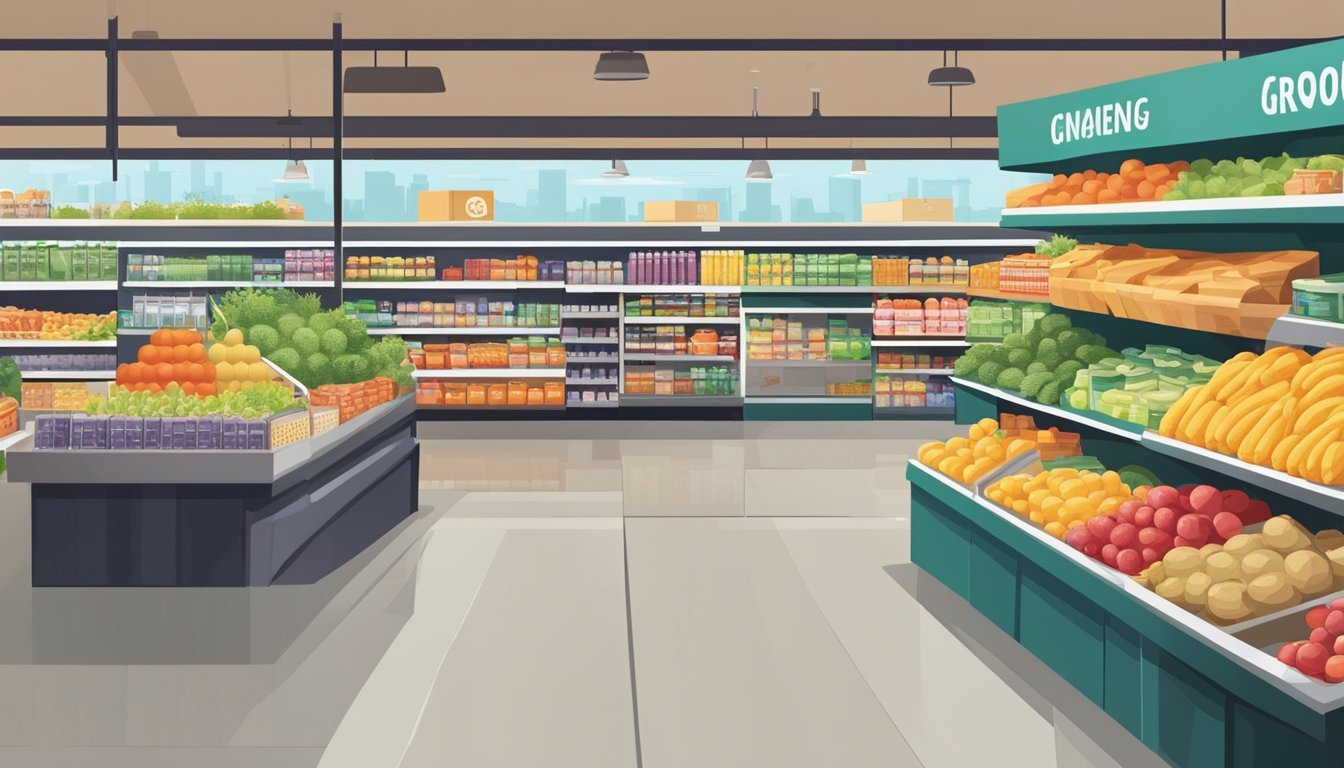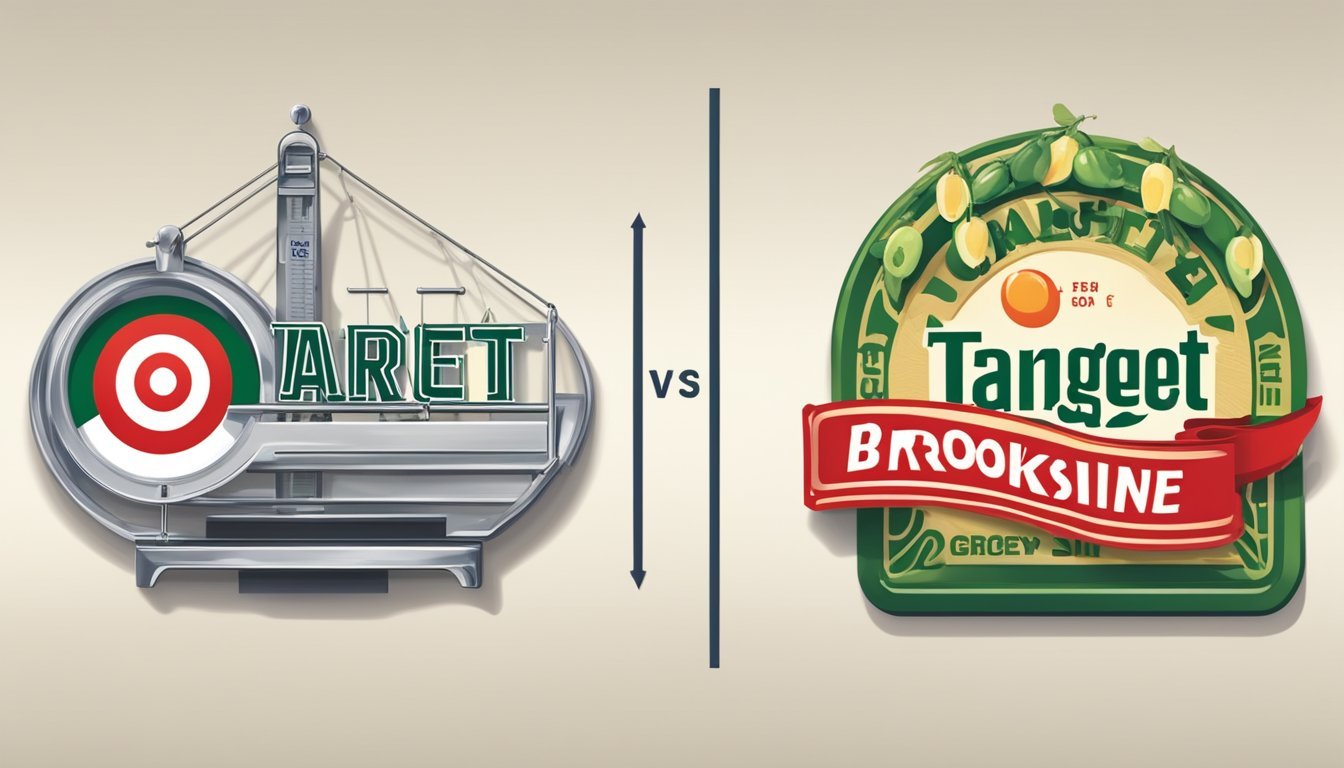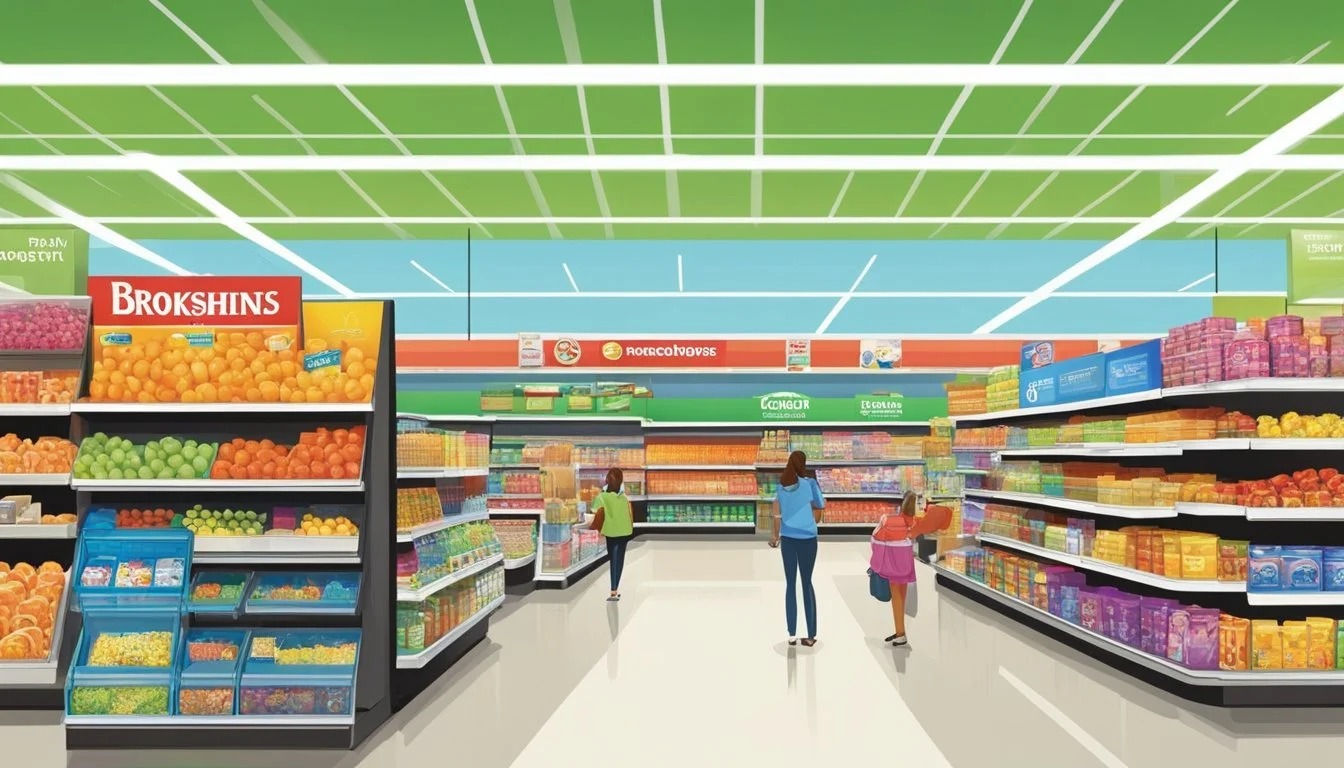Target vs Brookshire Grocery Company
Comparing Prices, Selection, and Customer Experience
Target and Brookshire Grocery Company offer distinct shopping experiences for consumers seeking quality groceries and household essentials. While both aim to provide value, their approaches and offerings differ significantly.
Target, a nationwide big-box retailer, combines groceries with a wide range of other products, from clothing to electronics. Its stores typically feature modern designs and carry many exclusive brands. Target's grocery selection tends to be more limited than traditional supermarkets, but often includes trendy and organic options at competitive prices.
Brookshire Grocery Company, a regional chain rooted in East Texas, focuses primarily on groceries and emphasizes local connections. Its stores generally offer a more traditional supermarket layout and selection. Brookshire's may appeal to shoppers who prefer a dedicated grocery store experience with a community-oriented approach.
Company Overviews
Target and Brookshire Grocery Company are two distinct retail entities with unique histories and market positions. Target has grown into a nationwide discount retailer, while Brookshire's remains a regional grocery chain focused on serving communities in the southern United States.
History of Target
Target Corporation traces its roots back to 1902 when George Dayton founded Goodfellow Dry Goods in Minneapolis, Minnesota. The company rebranded as Dayton's Dry Goods Company in 1903 and later became Dayton Corporation.
In 1938, Dayton Corporation opened its first Target store in Roseville, Minnesota. The concept aimed to provide customers with quality goods at competitive prices in a clean, spacious environment.
Target expanded rapidly throughout the 1960s and 1970s. By 1975, Target became the company's top revenue producer. In 2000, the corporation changed its name to Target Corporation, reflecting its primary focus on the Target brand.
Today, Target operates over 1,800 stores across the United States, offering a wide range of products including groceries, clothing, electronics, and home goods.
History of Brookshire Grocery Company
Brookshire Grocery Company was founded in 1928 by Wood T. Brookshire in Tyler, Texas. The company began as a single 25 x 100-foot store and has since grown into a regional supermarket chain.
Throughout the 1940s and 1950s, Brookshire's expanded its presence in East Texas. The company introduced innovations such as air conditioning and frozen food cases, enhancing the shopping experience for customers.
In the 1970s, Brookshire's launched its own distribution center to improve efficiency. The company continued to grow, acquiring other regional chains and expanding into Louisiana and Arkansas.
Today, Brookshire Grocery Company operates over 200 stores under various banners including Brookshire's, Super 1 Foods, Spring Market, and Fresh by Brookshire's. The company remains headquartered in Tyler, Texas, and focuses on serving communities in Texas, Louisiana, and Arkansas.
Geographic Presence
Target and Brookshire Grocery Company have distinct geographic footprints that shape their market strategies and customer bases. Target operates on a national scale, while Brookshire maintains a focused regional presence.
Target's National Reach
Target boasts a widespread presence across the United States. The retailer operates over 1,800 stores in all 50 states and the District of Columbia. This extensive network allows Target to serve diverse communities and leverage economies of scale.
Target's national presence enables consistent brand recognition and shopping experiences for customers across the country. The company's large-scale operations facilitate efficient supply chain management and distribution.
Brookshire's Regional Focus
Brookshire Grocery Company concentrates its operations in four states: Texas, Louisiana, Arkansas, and Oklahoma. With over 200 stores, Brookshire's has established itself as a prominent regional grocer in the southern United States.
This regional focus allows Brookshire's to tailor its offerings to local preferences and maintain strong community ties. The company's stores operate under various banners, including Brookshire's, Super 1 Foods, and Spring Market.
Brookshire's regional strategy enables more agile decision-making and responsiveness to local market conditions. The company's deep roots in these states foster customer loyalty and a reputation for understanding regional tastes and needs.
Product Range and Quality
Target and Brookshire Grocery Company offer distinct product selections to cater to different customer needs. Both retailers strive to provide quality options across various categories.
Inventory of Grocery Items
Target's grocery section features a curated selection of essential items. The retailer focuses on popular brands and their own store labels. Target's inventory includes dry goods, canned foods, and frozen items.
Brookshire Grocery Company provides a more extensive range of grocery products. Their stores stock a wider variety of brands and specialty items. Customers can find niche products and regional favorites at Brookshire's.
Target excels in offering trendy and health-conscious options. Brookshire's strength lies in its comprehensive selection of traditional grocery staples.
Focus on Fresh Produce and Meats
Fresh produce quality varies between the two retailers. Target's produce section is typically smaller but emphasizes organic and pre-packaged options. Their fruit and vegetable selection caters to convenience-oriented shoppers.
Brookshire Grocery Company places a stronger emphasis on fresh produce. Their stores often feature larger produce departments with a wider variety of fruits and vegetables. Brookshire's sources from local farms when possible, providing fresher options.
In the meat department, Brookshire's offers a more extensive selection. They carry USDA Choice Beef and often have in-house butchers. Target's meat options are more limited, focusing on pre-packaged cuts and popular choices.
Store Brand Comparison
Both retailers offer their own store brands. Target's "Good & Gather" line covers a wide range of products, from pantry staples to fresh produce. The brand focuses on quality ingredients and no artificial flavors or sweeteners.
Brookshire's store brands include "Food Club" and "Top Care" for groceries and household items. These brands aim to provide value while maintaining quality standards comparable to national brands.
Target's store brands often feature modern packaging and trendy flavors. Brookshire's private labels focus on offering traditional products at competitive prices.
Both retailers' store brands undergo quality testing to ensure customer satisfaction. However, the range of store-brand products is typically more extensive at Brookshire Grocery Company.
Pricing Strategies
Target and Brookshire Grocery Company employ distinct pricing strategies to attract and retain customers. Their approaches to everyday prices, discounts, and promotions significantly impact shoppers' overall grocery bills.
Overview of Pricing Models
Target uses a hybrid pricing model, combining competitive everyday prices with frequent promotions. The retailer focuses on offering value through its private label brands and a mix of national brands. Brookshire Grocery Company, on the other hand, emphasizes consistent pricing across its stores. They aim to provide competitive prices on staple items while maintaining quality standards.
Target's "expect more, pay less" philosophy translates to slightly higher prices on some items, offset by savings in other categories. Brookshire's pricing strategy centers on regional market dynamics, often resulting in prices tailored to local competition and consumer preferences.
Comparison of Everyday Prices
When comparing everyday prices, Target generally falls in the mid-range among major retailers. Their prices are typically higher than discount chains like Walmart or Aldi but lower than upscale grocery stores. Brookshire Grocery Company's prices tend to be competitive within their operating regions.
A basket of common grocery items at Target might cost 5-10% more than at Walmart. Brookshire's prices are often closer to Kroger's, with some variation based on location. Both Target and Brookshire's offer lower prices on their store brands compared to national brands.
Target: Mid-range pricing
Brookshire's: Regionally competitive
Walmart: Generally lowest prices
Kroger: Similar to Brookshire's
Discounts and Promotions
Target's promotional strategy includes weekly circular deals, cartwheel offers in their app, and a 5% discount for RedCard holders. These promotions can lead to significant savings when combined. Target also runs seasonal sales events that feature deep discounts on specific categories.
Brookshire Grocery Company offers a more traditional approach to discounts. They provide weekly specials advertised in circulars and through their website. Their loyalty program, called "Thank You Card," offers personalized discounts and fuel rewards.
Target promotions:
Weekly circular deals
Cartwheel app offers
5% RedCard discount
Seasonal sales events
Brookshire's promotions:
Weekly specials
Thank You Card loyalty program
Fuel rewards
Both retailers use their promotional strategies to drive traffic and compete with low-price leaders like Walmart and Aldi.
Shopping Experience
Target and Brookshire Grocery Company offer distinct shopping experiences tailored to their customer bases. Each retailer employs unique strategies in store design, customer service, and technology implementation to enhance the shopping process.
Store Layout and Design
Target's stores feature wide aisles and clearly marked departments, creating an open and inviting atmosphere. The retailer's signature red accents and modern fixtures contribute to a cohesive brand identity. Target often incorporates boutique-like displays for specialty items, particularly in clothing and home goods sections.
Brookshire's stores typically have a more traditional grocery layout. They focus on efficient product placement and easy navigation. The company emphasizes cleanliness and organization in their stores, ensuring a tidy shopping environment. Brookshire's stores often have a hometown feel, reflecting their roots as a regional grocer.
Customer Service
Target trains its staff to be approachable and knowledgeable about store offerings. Self-checkout options are available for customers who prefer a quick exit. The retailer also offers in-store pickup for online orders, blending digital and physical shopping experiences.
Brookshire's prides itself on personalized customer service. Their employees often develop relationships with regular shoppers, fostering a community-oriented atmosphere. The company emphasizes courtesy and helpfulness, with staff readily available to assist customers in finding products or answering questions.
Technology and Efficiency
Target has invested heavily in retail technology. Their mobile app allows customers to create shopping lists, find item locations, and access digital coupons. In-store kiosks provide product information and inventory checks. Target's REDcard program offers additional savings and perks for frequent shoppers.
Brookshire's has also embraced technology to enhance efficiency. They offer digital coupons through their website and mobile app. Some locations feature electronic shelf labels for quick price updates. The company's loyalty program provides personalized deals based on shopping habits, improving the overall customer experience.
Convenience Services
Target and Brookshire Grocery Company offer various convenience services to enhance the shopping experience. These range from digital solutions to in-store amenities designed to save time and effort for customers.
Online Shopping and Delivery Options
Target provides robust e-commerce capabilities through its website and mobile app. Customers can browse products, place orders for home delivery, or opt for in-store pickup. Same-day delivery is available in many areas through Shipt, Target's delivery service. The retailer also offers Drive Up, allowing shoppers to place orders online and have items brought to their car.
Brookshire's online shopping options vary by location. Some stores offer curbside pickup and home delivery through third-party services like Instacart. The company's BGGO app enables customers to create shopping lists and access digital coupons.
In-Store Services
Target features in-store pharmacies at many locations, providing prescription services and vaccinations. Self-checkout kiosks are widely available, reducing wait times at checkout. Many stores include Starbucks cafes and Target Cafes for quick refreshments.
Brookshire's in-store services include full-service meat and deli counters. Many locations offer money services like Western Union transfers and bill payments. Some stores feature in-store pharmacies and fuel stations for added convenience.
Both chains provide loyalty programs. Target's Circle program offers cashback rewards and personalized deals. Brookshire's Thank You Card provides discounts and fuel savings at participating locations.
Community and Customer Engagement
Target and Brookshire Grocery Company prioritize community involvement and customer satisfaction through various initiatives. Both retailers recognize the importance of fostering strong connections with their local communities and rewarding customer loyalty.
Corporate Social Responsibility
Target's corporate social responsibility efforts focus on education, sustainability, and community development. The company donates 5% of its profits to local communities, totaling over $1 billion annually. Target's education initiatives include school library makeovers and grants for field trips.
Brookshire Grocery Company emphasizes local community support. The retailer sponsors food drives, supports local schools, and provides disaster relief assistance. Brookshire's also operates a employee-driven charitable foundation that contributes to various causes in their operating areas.
Both companies actively participate in environmental sustainability efforts. Target aims to reduce its carbon footprint, while Brookshire's focuses on reducing food waste and promoting recycling programs in its stores.
Customer Loyalty Initiatives
Target's REDcard program offers customers 5% off purchases, free shipping, and extended return periods. The retailer also provides a mobile app with exclusive deals and personalized recommendations based on shopping history.
Brookshire's Thank You Card program allows customers to earn points on purchases, which can be redeemed for discounts on groceries and fuel. The company also offers digital coupons and personalized deals through its mobile app.
Both retailers prioritize customer feedback and satisfaction. Target conducts regular surveys and maintains active social media presence to address customer concerns. Brookshire's emphasizes personalized customer service in its smaller-format stores.
Brand Perceptions and Market Surveys
Target and Brookshire Grocery Company have distinct brand images and customer perceptions. Market surveys reveal insights into how consumers view these retailers and their offerings.
Public Image and Brand Value
Target has cultivated a strong national brand identity. The company is known for its stylish yet affordable merchandise and clean store environments. Target's private label brands, like Good & Gather and Favorite Day, have gained significant traction with consumers.
Good & Gather has grown into a $3 billion brand since its 2019 launch. It offers high-quality, health-conscious options at competitive prices. Favorite Day, introduced in 2021, focuses on indulgent treats and is experiencing double-digit growth.
Brookshire Grocery Company maintains a more regional presence. The company emphasizes community involvement and personalized customer service in its brand messaging.
Customer Perceptions and Reviews
Surveys indicate mixed customer sentiments for both retailers. Target's Net Promoter Score (NPS) varies by location but generally falls in the positive range. Customers appreciate Target's product selection and store aesthetics.
Brookshire Grocery Company's NPS stands at -5, with 46% promoters and 51% detractors. This suggests room for improvement in customer satisfaction.
Pricing strategies play a crucial role in shaping perceptions. Target is viewed as offering good value, especially through its private labels. Brookshire focuses on competitive pricing and local promotions to attract budget-conscious shoppers.
Customer experience surveys highlight strengths and weaknesses for each retailer. Target receives praise for its digital integration and convenient shopping options. Brookshire earns high marks for friendly staff and community engagement.
Future Outlook and Expansion Plans
Target and Brookshire Grocery Company are pursuing different growth strategies as they look to expand their presence in the competitive grocery landscape. Both retailers are focusing on new store formats and distribution capabilities to meet evolving consumer needs.
Target's Growth Strategies
Target is investing heavily in its small-format urban stores, aiming to reach new customers in dense city centers. The retailer plans to open 200 of these smaller locations by 2025. Target is also expanding its same-day delivery and pickup services to provide more convenience.
To support growth, Target is building new distribution centers optimized for e-commerce fulfillment. The company is remodeling existing stores to create dedicated pickup areas and improve the shopping experience.
Target continues to refine its grocery offerings, expanding organic and natural food selections. Private label brands like Good & Gather are a key focus for driving sales and loyalty.
Brookshire's Expansion Endeavors
Brookshire Grocery Company is taking a measured approach to expansion, focusing on its core markets in Texas, Louisiana, and Arkansas. The company plans to open new stores selectively in areas with strong growth potential.
Brookshire's is developing a "new generation" Fresh by Brookshire's concept store in Longview, Texas. This upscale format features extensive prepared foods, specialty departments, and an enhanced shopping experience.
To improve efficiency, Brookshire's is investing in technology upgrades for its distribution network. The company is also remodeling existing stores to modernize them and add services like online ordering with curbside pickup.
Brookshire's aims to compete through personalized service and strong community connections in its regional markets.










